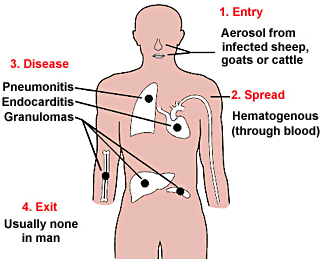Q fever is a disease acquired from animals caused by Coxiella burnetii, a rickettsialike organism of low virulence but remarkable infectivity.
A single organism can cause illness. In addition, despite the fact that C burnetii is unable to grow or replicate outside host cells, a sporelike
form of the organism is extremely resistant to heat, pressure,
and many disinfectants. This allows C burnetii to persist in the environment for long periods under harsh conditions.
In contrast to this high degree of inherent resilience and transmissibility,
the acute clinical disease associated with Q fever is usually
a benign, although temporarily incapacitating, illness in humans.
The potential of C burnetii as a biowarfare agent is related directly to its infectivity.
It has been estimated that 110 pounds of dried C burnetii would produce the same number of casualties as similar amounts
of anthrax or tularemia organisms.
|
| . |
| Symptoms |
Fever, cough, and pleuritic chest pain may occur as early as ten
days after exposure. Patients are not generally critically ill,
and the illness lasts from 2 days to 2 weeks.
|
|
How does it spread?

Ticks
|
Person-to-person transmission is rare.
Humans acquire the disease by inhaling particles contaminated with the organisms. The most
common animal carriers are sheep, cattle and goats. Farmers and
abattoir workers are at greatest risk occupationally.
Q fever has been transmitted from heavily contaminated unwashed
laundry; therefore the laundry must be marked and managed as infectious
material. Sputum and urine from patients should be autoclaved
before disposal.
|
| Diagnosis |
Q fever is not a clinically distinct illness and may resemble
a viral illness or other types of atypical pneumonia. The diagnosis
is confirmed by serum tests.
|
Treatment
|
Tetracycline or doxycycline should be started 8-12 days after
exposure and continued for 5 days. This regimen has been shown
to prevent clinical disease.
Specifics on treatment can be found here
Decontamination is accomplished with soap and water or a 0.5%
chlorine solution on personnel.
|
Vaccine
|
An inactivated whole cell unlicensed vaccine is effective in for
protection against exposure, but severe local reactions to this
vaccine may be seen in those who already possess immunity. Therefore,
an intradermal skin test is recommended to detect pre-sensitized
or immune individuals.
|
Mortality
|
Even without treatment, most patients recover. The exception is
when chronic Q fever infection inflames the heart. Then the mortality
rate is 24% even when patients receive appropriate treatment.
|
Sources:
USAMRIID's Medical Management of Biological Casualties Handbood;
Fourth Edition February 2001; pages 9-10; http://usamriid.detrick.army.mil/education/bluebook/bluebook.pdf
Federation of American Scientists; http://www.fas.org/nuke/intro/bw/agent.htm
CBRNE - Biological Warfare Agents; http://www.emedicine.com/emerg/topic853.htm
Virtual Naval Hospital: Treatment of Biological Warfare Agent
Casualties; http://www.vnh.org/FM8284/index.html
|

